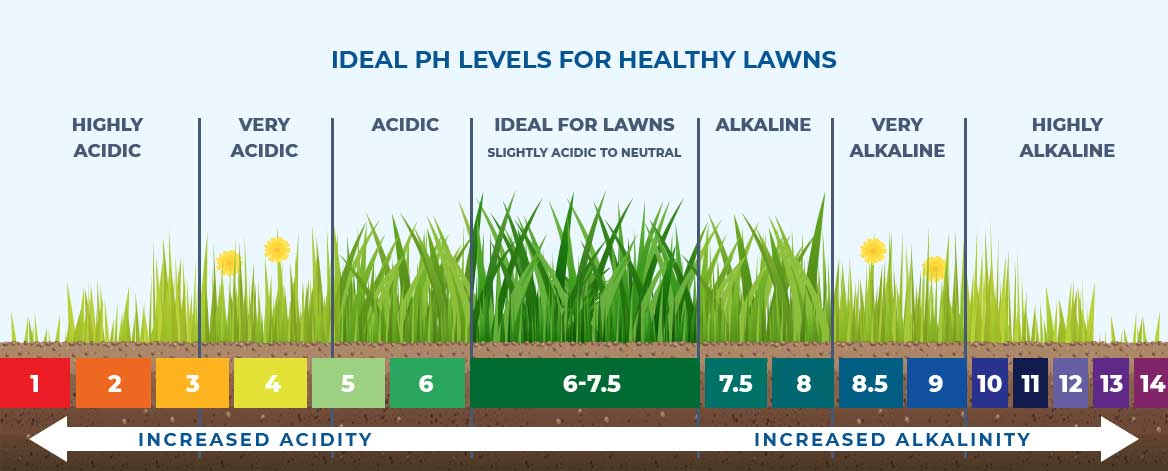Achieving and Maintaining the Perfect Lawn
The Definitive Lawn Care Guide
For most people the first sign of Spring is signaled by greenery starting to appear. From tree leaves to blades of grass, the coming to life of nature is a welcome occurrence, however, for some the emerging of new growth can signal another season of battle between man and lawn. We have compiled tips and tricks for not only perfecting your lawn but also maintaining it.

CHAPTER 1
Prepping Your
Lawn

CHAPTER 2
Weeding Your
Lawn

CHAPTER 3
Feeding Your
Lawn

CHAPTER 4
Mowing Your
Lawn

CHAPTER 5
Watering Your
Lawn

CHAPTER 6
Hiring
Professionals
CHAPTER 1
Prepping Your Lawn
Start with a clean lawn at the beginning of the season to reduce work during the summer months.

Start Early with a Clean Slate:
As the weather starts to warm it is a good time to prep your lawn. Rake leftover leaves and debris from fall. Pick up and remove twigs, rocks, and pinecones.
Starting with a clean lawn will reduce work during the summer months.
Regular lawn tidy up will also reduce the time necessary to prep your lawn for the winter as well.
Aerate:
When soil is packed down too tightly, it becomes difficult for sunlight, water and nutrients to make their way to the grassroots, impeding the growth of your lawn.
Aerating will allow for oxygen and sunlight to easily find its way to the grass root which will inturn grow deeper, resulting in a stronger and healthier lawn.
There are a number of companies that offer lawn aerating for reasonable pricing, or if you prefer to do-it-yourself, rentals are also an option.
There are 3 methods that will help you achieve different levels of aeration.

Core Aeration
Core aeration is the most common method used on lawns today. The process of core aeration involves approximately 3 inch cores being pushed into the soil and pulled out every couple of inches.
This will result in “plugs” being spread around your lawn, which in time will be redistributed once broken back down.
This method is used for heavily compacted earth and promotes growth of healthy grass as it allows for water, sunlight and nutrients to easily penetrate the soil.

Spike Aeration
This method proves to be effective for lawns that have not been compacted heavily.
Spike aeration uses spikes to create holes by pushing down the dirt, not removing it like the core method.
This aeration process is helpful as a lawn pre-treatment prior to fertilization, priming for optimal absorption.

Liquid Aeration
Exactly as described, liquid aeration is the process of spraying ones lawn with a solution that creates microscopic pores that act as sponges that aid in absorbing and retaining water and nutrients.
The main benefit of the liquid method is its ability to cover your entire lawn.
Regardless of which method you determine to be best, aerating is a key step to achieving a healthy and thriving lawn.
CHAPTER 2
Weeding Your Lawn
It’s time to ensure that last year's weeds don’t become this year's problem.

Now that your property is prepped for the new season, it is important to ensure that last years weeds don’t become this years problem.
There are a number of weeds that seem to plague neighbourhoods.
There are two kinds of weeds found, grassy weeds and broadleaf weeds. Grassy weeds tend to grow in bunches that will creep and spread if left to their own devices.
They have a fibrous mass root system with very small branches.
The alternative is the broadleaf weed, which as described in their name, have broadleaves. Their root system is also fibrous with a large tap root, series of thin roots or a combination of the two.
Below is a run down of the most common ones and what you can do to combat them.
Dandelion
● One of the first weeds to sprout
● Provide necessary food sources for pollinating insects
● Self-pollinator - seed heads distribute once the yellow petals have died
● Develop a large tap root
● Perennial weed will return each year if not removed
How do I get rid of dandelions?
● The key is to remove the tap root
● Pull, dig or use a weed puller or smother (remove light source)
● Apply boiling water, salt or vinegar to the plant

Probably the most popular and recognizable weed, the dandelion has a habit of spreading quickly and popping up on even the most manicured lawns. And you can thank the neighbourhood kids for that.
We’ve all closed our eyes, made a wish and unknowing have blown hundreds of seeds onto unsuspecting lawns. Yes, those magic puff balls are the beginnings of dandelions you’ll be yanking out all summer.
Unless you start early and attack the problem! Dandelions are one of the first weeds to sprout and provide necessary food sources for pollinating insects such as the honeybee.
However, they don’t require any assistance spreading their seed as they are “self-pollinators”. Once the yellow flower petals have dried up the seed head emerges. One strong gust of wind and they have now been distributed over your lawn. Combine that with optimal growing conditions and it is easy to see why they are the source of headaches. Dandelions will develop a large tap root, however, prior to that they will sprout leaves in order to capture sunlight for growth. Once the’ve set up a healthy source of energy via their leaves the tap root will quickly grow deep within the ground, pulling water and nutrients easily.
When attempting to eradicate ones lawn, you must make sure to fully remove the tap root in order to stop the life cycle, otherwise there is no slowing them down. And added bonus, they are perennials, so if not dealt with they will be back year after year...after year.
There are a number of different ways you can rid your lawn of dandelions, many of which can be done without the use of chemicals.
1. The best way to quickly and permanently remove dandelions is to fully remove the plant and root manually. Whether you pull, dig out or remove with a “weed puller” you will need to fully remove the tap root. You will know when you’ve been successful as the root is easy to spot.
2. Smothering the plant is also an option and involves covering the dandelion with cardboard or a dark plastic bag, blocking the sunlight and killing the weed. This usually takes a few days.
3. Mowing over a dandelion will temporarily remove the flower from your lawn however, they will grow back as the root system remains in tack.
4. There are a number of different household items you can put on the plant such as vinegar, salt or boiling water that will kill them overtime as well.
Creeping Charlie
● Scientific name is Glenchoma Hederacea
● Can be very aggressive and invasive
● Spreads quickly and takes over large sections of lawn
● Forms a dense mat that is unsightly and hard to remove
● Can survive in shaded moist areas but also tolerates sunlight
● It spreads either by seeds or by stolons - horizontal connections between the plant
How do I get rid of creeping charlie?
● The key is to remove all of the root and repeat as new growth appears
● Pull, smother and cut as much of the plant as possible
● Pour boiling water, vinegar or salt on the plant
● Be persistent and continue until weed no longer regrows

Better known as “creeping charlie”. This weed is aggressive and invasive and when not dealt with properly it can spread quickly and take over large sections of lawn.
If allowed, creeping charlie will form a dense mat that is not only unsightly but hard to remove.
Because it can survive in shaded, moist areas but also can tolerate sunlight it becomes a double threat. Creeping charlie is spread one of two ways.
Either by its seed or by growing from stolons, which are the horizontal connections between the plant.
How do I get rid of creeping charlie?
In order to effective remove creeping charlie from your lawn you will have to make sure to remove all of the root and leaves.
If clippings or stray leaves/roots are left behind they can germinate again and regrow. Best practice is to hand pull as much as possible, ensuring to compost in a closed container. It will need to be repeated as new growth is noticed.
Much like dandelions you would be able to remove this weed without the use of harsh chemicals. Pulling, smothering, cutting and pouring vinegar/boiling water and/or salt will all kill creeping charlie as well. It’s worth noting, that because of the connective root system pulling out creeping charlie is a cumbersome task that will require more than one attempt to make sure it as fully been removed from your lawn. For quick and effective treatment a weed killer would do the trick.
Wild Violet
● Aggressive and resilient weed
● Grows short, avoids lawn mower
● Broadleaf weed
● Self seeder
● Grows in shady, moist areas but can withstand sunlight
How do I get rid of wild violet?
● Apply weed killer

Despite its beautiful name, the wild violet is an aggressive and resilient weed. The wild violet is adaptive to the point it will grow shorter in order to avoid being cut by lawnmower blades. This broadleaf weed is also a self seeder meaning during its growth cycle it will produce and drop seeds that germinate in the fall, lie dormant for the winter and sprout in the spring. If left, the wild violet, will also continue to grow through its underground root system. Starting out in shady, moist areas, this tiny flower impersonator, will migrate to sunny areas if necessary.
How do I get rid of wild violet?
Nearly impossible to eradicate by hand, most homeowners will need to come to one of two conclusions, use a weed killer to remove or allow the plant to remain.
CHAPTER 3
Feeding Your Lawn
Learn the differences between fertilizers and the best lawn food based on soil types.

Once you have identified and tackled your weed situation, next you will want to consider feeding your lawn.
The first step, prior to fertilizing, is testing your soil.
There are a wide variety of soil types that will require different types of fertilizers to achieve a well balanced base.
Over or incorrect application of fertilizing can be harmful to your lawn as well as the environment.
When testing you will be determining your soils alkalinity/acidity levels.
The scale ranges from 0-14, 0 being extremely acidic, 14 being extremely alkalined, and 7 being neutral.
Upon receiving the results of your test you will need to either apply a limestone product if your soil is overly acidic or sulfur product is overly alkalined.
In order to get an accurate sample, you will want to obtain 5-6 scoops of soil, from different areas of your lawn, approximately 4-6 inches below the surface. Remove grass and roots, mix together and lay out on newspaper to dry.
You will then need to send the sample to a lab to be tested.
How do I fertilize my lawn?

You’ve determined what your lawn now needs to thrive, so now it is just a matter of providing that proper fertilizer.
Ideally, once established a regular lawn maintenance schedule, you will have fertilized your lawn late fall of the previous year.
This will ensure your grass will have all it needs to tolerate the winter months and come back healthy and green in the spring.
Depending on the amount of fertilizing required will determine when would be the best time to apply.
Assuming you fertilized at the end of the previous season you will want your first (or second depending on how many times fertilizing was done the previous fall) application to be done in late Spring.
If you had not fertilized, your first time would be in late summer or early fall. More than one feed may be required, if that is the case you will need to do so a second time in late summer or early fall.
The final fertilization will be done in late fall, when the grass has stopped growing up still has its colour.
Feeding is a vital step when trying to achieve thick, luscious grass.
Your lawn requires three main nutrients in order to not only survive but thrive.
Nitrogen, which promotes the vibrant colour, Phosphorus which aids in root health and Potassium, which strengthens grass for inevitable wear and tear, possible drought and the winter months.
Fertilizers will have ratios of Nitrogen, Phosphorus and Potassium on their labels, listed as N-P-K.
This assists customers when they are looking for specific nutrient amounts. When determining what to use to for fertilization you will have the choice between organic and chemical.
Not be confused with the term used on fruits and vegetables, the term organic refers to the ingredients to be derived from plants or animals.
Synthetic, or chemical, is made up of petroleum by-products, gasses for the air, minerals and other materials.
Both have pro’s and con’s which we will briefly run through below.

What are the Pros and Cons of Organic Fertilizer?
Pros:
● Made up solely of natural or animal derived products
● Improves the overall structure of the soil for long term healthy and vitality
● Slow release - low chance of over fertilization
● Environmentally friendly
Cons:
● Assistance for breakdown needed from microorganisms, which is limited to warmer weather
● Slow release - takes longer to see results
● N-P-K ratios are not easily determined

What are the Pros and Cons of Conventional Fertilizer?
Pros:
● Quick release - improvement seen within a couple days
● Improves the overall structure of the soil for long term healthy and vitality
● N-P-K is exact - easy to determine what to give lawn
● Inexpensive
Cons:
● Focus on plant growth, not overall sustainability of soil
● Made from nonrenewable sources
● Possibility of over fertilization
● Can lead to toxic build up
Regardless of which method you use, fertilizing ones lawn is an important step when hoping to achieve the picture perfect property.
CHAPTER 4
Mowing Your Lawn
Here, we will explain how to effectively mow your lawn to promote the healthy growth of grass

You’ve got your lawn off to a healthy start and it’s time to enjoy the fruits of your labour; long, thick grass!
The work doesn’t stop here.
Most of us don’t put in much thought when it comes to cutting the lawn; however, if incorrectly, you could be doing more harm than good.
There are a number of things to remember before you begin.
1. Less is more: It would seem to make sense that cutting more off would result in less time spent mowing the lawn, and while that is true it is not beneficial to the well being of the grass to do so. Raising your mower blade and only cutting off the top 1/3 portion is recommended. Not trimming so much off allows for the energy to be focused on roots growing deeper and stronger vs. growing the grass blade again. Also taller grass blades can make it more difficult for weeds to grow, help shade and protect the soil and feel much more comfortable when walking on.
2. The sharper, the better: A sharp blade will cut the grass cleanly across, where a dull blade will end up ripping and leaving the grass uneven and discoloured. When the grass blades are torn they are also more susceptible to disease, insects and effects of severe weather. A quick sharpen and the beginning of the season and as need throughout, will keep your grass looking and feeling its best.
3. Mix it up!: We are creatures of habit and that transfers to the direction we cut our lawns as well. Although it's tempting to stick to a pattern, its most beneficial to switch it up a bit! Grass will adapt to the way it's being cut and begin to lean towards that direction. In order to have grass stand up nice and tall, alternate cut patterns throughout the year.
4. Ditch the rake: It may be tempting to rake up grass clippings after mowing; however, you will be doing the lawn a disservice. Clipping are a source of nutrients for the soil and breakdown rather quickly, especially if you are cutting less off the top.
Other things to consider when cutting is make sure to cut when the grass is dry, this will not only save your lawn mower but also avoid clippings from clumping to heavily and smothering the grass.
CHAPTER 5
Watering Your Lawn
Watering your lawn is one of the most important factors to achieving and maintaining the perfect lawn, learn how to do it right!

This is arguably the most important factor when it comes to achieving and maintaining the perfect lawn.
Nothing is more beneficial or detrimental than the amounts of water grass receives.
You can apply all the above principles and it would not make one difference if you are incorrectly watering your grass.
The frequency and time of day are of vital importance when watering.

Do:
● Water your lawn after midnight or very early in the morning as it’s calmer and cooler
● Water your lawn twice a week if there is no rainfall
● Use a sprinkler system to provide even distribution of water

Don't:
● Water your lawn in the afternoon as the heat will evaporate water
● Water your lawn in the evening as mold and fungus can grow
● Overwater your lawn which can lead to grass suffocation and fungus growth
When should I water my grass?
It is suggested that you water your property in the morning.
The morning is typically calmer and cooler.
Afternoon heat and sun can cause excess evaporation, where as evening watering does not allow for the lawn to dry thoroughly leaving the grass susceptible to fungus and disease.
How often should I water my grass?
Healthy lawns will only require between 1-1.5 inches of water per week either from rainfall or manual watering done a maximum of twice a week.
To ensure your lawn is receiving sufficient amounts, water for approximately 15 mins and check your soil.
Ideally, you will want water to penetrate 6-8 inches.
Less than that will result in a shallow root system that dries out too quickly. Anything more than that will be unnecessary as grass roots don’t reach down further.
Overwatering can lead to fungus growth, suffocate grass and roots and cause excess runoff.
Water is a valuable resource and as such minimizing waste should be a priority. If not only for your wallets sake.
How should I water my lawn?
It is suggested that you water your property in the morning.
If there's not enough rain falling, manual watering will be needed to ensure your lawn stays healthy and lush. Most people resort to using a sprinkler system to handle this for them.
The two most common types of sprinklers are pulsating sprinklers or oscillating sprinklers.
Pulsating tends to be better than the more traditional oscillating because it shoots the water horizontally across the lawn vs. straight up in the air, where wind can blow it away.
That being said on newly seeded lawns, oscillating sprinklers have a lower chance of washing away seed.
What are the benefits of an irrigation system?
Ideally, an irrigation system would handle all your watering needs.
As technology has advanced, irrigation systems have become intuitive, learning your lawn and supplying the exact amount of water needed and the best times.
An installed irrigation system can save money, time and most importantly, virtually eliminate overwatering.
Not everyone’s schedule also for early morning waterings. Sprinkler systems com with automated timers that make sure to water your lawn at the best time of day to ensure the most water is absorbed without waste.
Also with travelling many of us are away for extended periods of time. Instead of paying for a service or resorting to asking neighbours or family member, your system can ensure your property is well taken care of while you are enjoying your vacation. Irrigation can put your mind at ease knowing your property is being properly and intuitively watered even when there is no one home.
Nowadays, homeowners will be surprised at the ease and affordability and can rest easy knowing all their hard work is being maintained by a perfectly timed water irrigation system.
Not only will you save yourself time and resources, you will be adding value to your life and property.
CHAPTER 6
Hiring a Professional
Consider hiring a professional to provide expert care for your lawn

At the end of the day, lawn maintenance might not make the top of everyone’s priority list. If you fall under this category, you may want consider hiring someone or a small business to handle the work for you. There are a number of benefits of having a professional lawn care company maintain your property. They bring knowledge and expertise as well as all the proper tools needed for the job. They can easily address and rectify any problem areas and ensure your lawn is in the best shape possible all year long. Depending on your property and schedule, you may be looking to hire for a specific job or weekly maintenance. Regardless of your needs there are many professional companies that would be able to provide these services.
Whether its being the envy of the neighbourhood or taking pride in your property, many of us strive to achieve a picture perfect lawn. There are a number of important steps to get there; however, with some dedication and information lush, green grass can be canvas on which summer memories are made.
